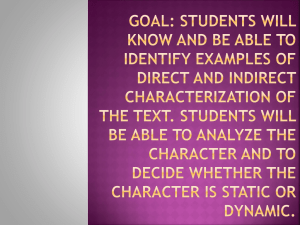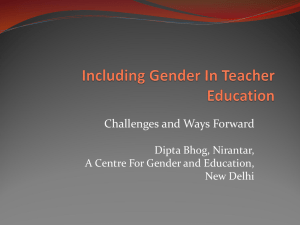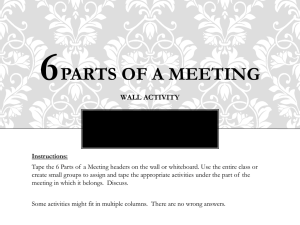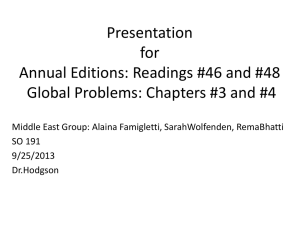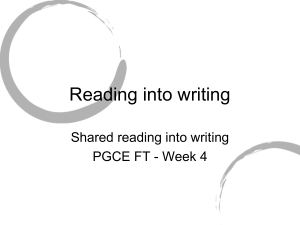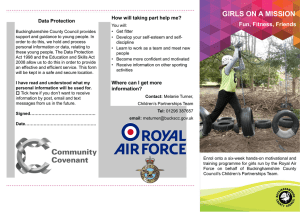Beauty Redefined: The Future of Girls
advertisement
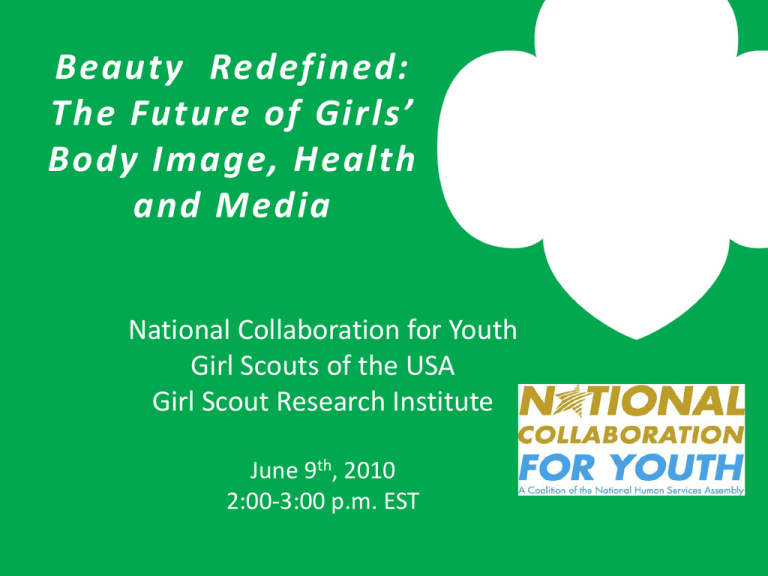
Beauty Redefined: The Future of Girls’ Body Image, Health and Media National Collaboration for Youth Girl Scouts of the USA Girl Scout Research Institute June 9th, 2010 2:00-3:00 p.m. EST Agenda 1) Voices of girls – research findings 2) External influences – media environment 3) Program solutions – It’s Your Story – Tell It! 4) Policy impact – Healthy Media for Youth Act Major Findings Studies brings voices of girls to forefront of conversation on childhood obesity, body image and adolescent health. Girls today are defining health on their own termsusing a complex & varied set of norms. Efforts to address the problem among girls focused soley on nutrition or physical activity will miss the mark. Setting the Stage: The Environment -- Society idealizes thinness/stigmatizes overweight -- Unhealthy food marketed at record highs -- Physical activity levels at record low --TV/Computers dominate recreation -- Communities lack safe space to play Eating Disorders & Obesity: Girls caught in the middle • Obesity is now the most chronic health problem among American children. • The strongest correlation for overweight girls is between weight and income. • Research suggests that eating disorders and overweight tend to co-occur. • There are benefits of collaborative efforts to curb all eating related disturbances. What percentage of girls report significant stress about their body image? a) 65% b) 25% c) 15% Body Image & Eating Disorders • One quarter of girls report significant distress about their body size and shape. • Body dissatisfaction increases risk for disordered eating, depressed mood, and low self-esteem. • Up to 10% of girls and young women might suffer from disordered eating. Holistic Health • Being healthy is emotional and physical well-being. • More than just eating right and exercising. • About feeling good about oneself, being supported and appearing “normal.” Self-evaluation Sick Addicted Overweight Underweight Unkempt Insecure 1 Vegetarians Athletes Health zealots 2 3 4 “Nobody wants to be that healthy.” 5 Healthy Unhealthy “Normal” Girls aspire to be “normal healthy” or “healthy enough.” 65% of girls said their lifestyle was “healthy enough for my age”. While most girls want to look normal, what that means can vary depending on a girls’ age, race, household income, peer group, adult role models and selfperception. African American and Latina girls who have higher rates of overweight, tend to be more satisfied with their bodies than White and Asian girls who have lower obesity rates. Older girls also tend to be less satisfied with their weight than younger girls. What percentage of girls who are overweight believe they are normal weight? a) 25% b) 45% c) 10% Striving for “Normal”— At Odds With Reality While most girls have an accurate perception of their own weight, as many as one-third of girls ages 8 to 17 have a distorted perception of their weight: 45% of girls who are overweight by BMI standards believe they are normal weight 14% of normal weight girls believe they are overweight 30% of normal weight girls ages 16-17 are trying to lose weight Self-esteem, body image, and stress are core components of emotional health. • Girls are more worried than boys about everything, especially appearance. • Being teased or made fun of it top worry for girls, especially for overweight girls. • More than 1/3 of girls ages 11-17 reported eating more when stressed out. “Active Identities” • The more physically active girls are, the greater their selfesteem and the more satisfied they are with their weight, regardless of how much they weigh. • 83% of very active girls say that physical activity makes them feel good about themselves. • Many girls do not play sports because: --They do not feel competent (40%) --They do not think their bodies look good (23%) The Mother-Daughter Connection A mother’s weight, body image, and health habits are strong predictors of whether her daughter: • Is overweight • Is satisfied with her body • Is physically active • Looks to her mother for advice on healthy living What can mothers/parents do to promote positive body image among girls? External Influences • “Girl-Power” media market culture • Sexualization of girls in the media • Ideal-body internalization “Girl Image Crisis” In The Media • Value centers on sexual & physical attractiveness rather than ability even at younger ages • Lack of female role models • Link between sexualization of girls in media and impact on self-esteem, sexual identity, eating disorders, depression, anxiety and shame Body Image & The Fashion Industry • Girls have a very conflicted relationship with the fashion industry. • Nine in ten girls say the fashion industry (89%) and/or the media (88%) place a lot of pressure on teenage girls to be thin. • 65% of girls think that the body image represented by the fashion industry is too skinny; 63% think it is unrealistic; and 47% think it is unhealthy. • More than a quarter (28%) say the fashion industry body image looks sick. What percentage of girls say fashion is really important to them? a) 30% b) 50% c) 75% Body Image & The Fashion Industry However: • 75% of girls say that fashion is really important to them. • 48% wish they were as skinny as the models in fashion magazines. • 47% say fashion magazines give them a body image to strive for. Many girls think that extreme weight loss strategies are acceptable. • 25% of girls think that it is acceptable for girls their age to take appetite suppressants or weight loss pills and 19% think that plastic surgery and/or weight loss surgery is acceptable. • More than half (55%) of girls admit to going on a diet to try to lose weight and 31% admit to starving themselves or refusing to eat. For girls who have negative body image, the effects and influences of fashion are especially pronounced. • 73% of girls with negative body image (versus 40% of those with positive body image) wish they were as skinny as the models in the fashion magazines. • This group of girls is more likely than their positive body image peers to: • Resort to drastic weight loss measures like starving themselves/refusing to eat (50% vs. 25%); and • Force themselves to throw up after eating (18% vs. 10%). • Almost one in five (19%) girls with negative body image have taken appetite suppressants or weight loss pills and 15% have taken a laxative to stay thin. Girls’ Call to Action for the Fashion Industry • 81% of girls would rather see “real” or “natural” photos of models than touched-up, airbrushed versions. • 75% would be more likely to buy clothes they see on “realsize models” than on super-skinny ones. This is particularly important to African American girls (82%). Recommendations for Policy Makers • Policy solutions should embrace a holistic definition of health. • Community-based organizations that serve youth should be seen as vital partners. The Healthy Media for Youth Act (H.R. 4925) • This research prompted Girl Scouts, along with the American Psychological Association, to work with Reps. Tammy Baldwin (D-WI) and Shelly Moore Capito (R-WV) to introduce the Healthy Media for Youth Act, H.R. 4925 • This bill focuses on improving youth’s media literacy and promoting healthy media messages about girls and women The Healthy Media for Youth Act (H.R. 4925) 1) Competitive grants for media literacy programs and youth empowerment groups 2) Research on how depictions of women and girls in media affect youth’s physical, emotional, and social health 3) Creates a National Task Force on Women and Girls in the Media to identify voluntary standards for promoting healthier media messages about girls and women. The Healthy Media for Youth Act (H.R. 4925) We need your help to increase support! How your organization can get involved: – Sign onto the support letter – Start letter writing campaign among your members and chapters/affiliates – Download advocacy web sticker to web site Website: www.girlscouts4girls.org Current Supporters Endorsements: Girl Scouts of the USA, The American Psychological Association, Alliance for Women in Media, Alpha Kappa Alpha Sorority, Inc., American Association of University Women (AAUW) Black Women’s Health Imperative, Children Now, Common Sense Media, Eating Disorders Coalition, Geena Davis Institute on Gender in the Media, Girls Inc., Kappa Delta Sorority/The Confidence Coalition Lifetime Networks, National Collaboration for Youth, National Eating Disorders Association, National Council of Negro Women, National Council of Women’s Organizations, National Women’s Law Center, New Moon Girl Media, Parents Television Council, Rachel Simmons, author of Odd Girl Out, Rosalind Wiseman, author of Queen Bees and Wannabes, Jess Weiner, author, self-esteem expert, founder of the Actionist Network(r) Women’s Media Center, and Wider Opportunities for Women. Co-sponsors: 39 in the House The Girl Scout Leadership Experience It’s Your Story – Tell It! Journey goal: get girls active to build their skills and accomplish goals, whether personal or project-related. Key Journey Elements : • • • • • • Ceremonies and Traditions Healthy Living Active, Outdoor Pursuits Global Ideas Take Action Projects Profiles of Inspiring Women and Girls It’s Your Story – Tell It! Connections to Self Esteem: • Holistic Health • Diversity • Leadership through Taking Action Why Storytelling? Stories are a great way for girls to understand themselves and their potential, and that leads to a stronger sense of self - the key intended leadership benefit of this journey series Storytelling is more than just the written word! Creative Expression and the Arts are integrated into each session plan: • • • • Performing arts Visual arts New media Culinary arts It’s Your Story—Tell It! TITLES and THEMES DAISY • 5 Flowers, 4 Stories, 3 Cheers for Animals! BROWNIE • A World of Girls JUNIOR • aMUSE CADETTE • MEdia SENIOR • MISSION: SISTERHOOD! AMBASSADOR • BLISS: Live It! Give It! The Girl Scout Leadership Experience It’s Your Story – Tell It! Visit: http://www.girlscouts.org/program/journeys/your_story/default.a sp for more information on It’s Your Story – Tell It! and download activities to try with girls! Please send additional program questions to: Sabrina Lee Sanchez, Project Coordinator uniquely ME! The Girl Scouts/Dove Self-Esteem Program ssanchez@girlscouts.org Conclusions and Recommendations • Give “health” social relevance to girls • Embrace a holistic definition of health • Emphasize physical activity • Focuses on ability not just appearance • Demonstrate positive outcomes that result from healthy behavior • Incorporate media literacy into programs • Advocate for policy changes to promote healthy media images • Target adult role models – especially mothers Questions for Discussion 1) What did you find most interesting/surprising about the research? 2) What are the challenges you face working with girls/youth on this issue? 3) What approaches have worked well? What do you think needs to be changed? 4) What is one thing you are going to carry forward into your thinking about girls, body image and health as a result of this webinar? 5) What is one piece of advice you have for girls who struggle with body image? What advice can you give to yourself? For more information contact Judy Schoenberg, Director, Research & Outreach (212) 852-6545 or at The Girl Scout Research Institute jschoenberg@girlscouts.org http://www.girlscouts.org/research/
